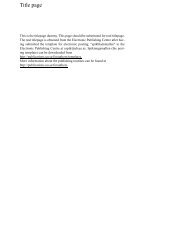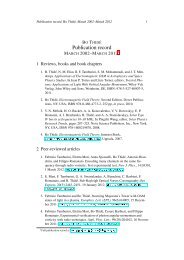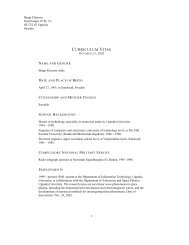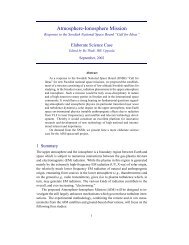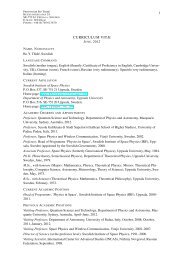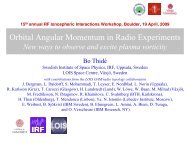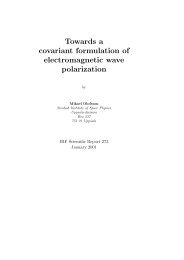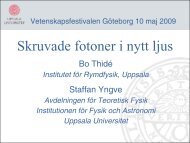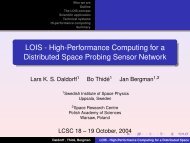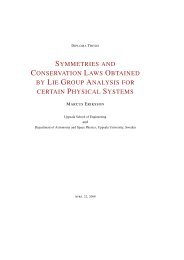L5_Astrodynamics-2 - Swedish Institute of Space Physics - Uppsala
L5_Astrodynamics-2 - Swedish Institute of Space Physics - Uppsala
L5_Astrodynamics-2 - Swedish Institute of Space Physics - Uppsala
Create successful ePaper yourself
Turn your PDF publications into a flip-book with our unique Google optimized e-Paper software.
Compass-2<br />
Microsatellite Technology<br />
<strong>L5</strong> – <strong>Astrodynamics</strong> 2<br />
Jan Bergman, January 28, 2010<br />
Adapted after Christian Hånberg’s lecture 2008<br />
E-mail: jb@irfu.se<br />
Tel. +46(0)18-4715916<br />
Room: Å84116<br />
<strong>Swedish</strong> <strong>Institute</strong> <strong>of</strong> <strong>Space</strong><br />
<strong>Physics</strong>, <strong>Uppsala</strong>, Sweden<br />
http://www.irfu.se
Part 1<br />
<strong>L5</strong> – <strong>Astrodynamics</strong> Part 2<br />
<strong>L5</strong> – <strong>Astrodynamics</strong> 2<br />
• Repetition Classical Orbital Elements<br />
• Orbit Maneuvering ch. 6.3<br />
Coplanar Orbit transfers<br />
Orbit Plane Changes<br />
Orbit Rendezvous<br />
• Launch Windows ch. 6.4<br />
• Orbit Maintenance ch. 6.5<br />
<strong>Swedish</strong> <strong>Institute</strong> <strong>of</strong> <strong>Space</strong> <strong>Physics</strong>, <strong>Uppsala</strong>, Sweden | www..irfu.se
Classical orbital elements<br />
<strong>L5</strong> – <strong>Astrodynamics</strong> 2<br />
• Shape<br />
a: Semi-major axis<br />
e: Eccentricity<br />
• Orientation <strong>of</strong> orbital plane<br />
i: Inclination (vertical tilt)<br />
• i < 90 prograde or direct<br />
• i > 90 retrograde<br />
Ω: Right ascension <strong>of</strong> the<br />
ascending node<br />
• Line <strong>of</strong> node - equator crossings<br />
• Orientation <strong>of</strong> the ellipse<br />
<br />
ω: Argument <strong>of</strong> perigee<br />
• Angle between ascending node<br />
and semi-major axis<br />
• Where (in time)<br />
<br />
v: True anomaly<br />
• Angle between satellite and<br />
perigee in the orbit plane<br />
<strong>Swedish</strong> <strong>Institute</strong> <strong>of</strong> <strong>Space</strong> <strong>Physics</strong>, <strong>Uppsala</strong>, Sweden | www..irfu.se
Orbit Maneuvering<br />
<strong>L5</strong> – <strong>Astrodynamics</strong> 2<br />
• A some point in most satellites life, one or more<br />
<strong>of</strong> the orbital elements have to be changed.<br />
This can be due to<br />
• orbit corrections,<br />
• transfer the satellite between different orbits,<br />
• rendezvous or intercept with another satellite.<br />
• To change the satellites orbit, we have to<br />
change the satellites velocity vector.<br />
<br />
∆v = v NEED - v CURRENT<br />
<strong>Swedish</strong> <strong>Institute</strong> <strong>of</strong> <strong>Space</strong> <strong>Physics</strong>, <strong>Uppsala</strong>, Sweden | www..irfu.se
Orbit maneuvering<br />
<strong>L5</strong> – <strong>Astrodynamics</strong> 2<br />
• Any maneuver<br />
changing the orbit<br />
<strong>of</strong> the satellite<br />
must occur at a<br />
point where the<br />
old orbit intersects<br />
the new.<br />
• If the two orbits<br />
don’t intersect we<br />
must use a<br />
transfer orbit,<br />
intersecting both<br />
orbits.<br />
1. Initial orbit<br />
2. Transfer orbit<br />
3. Final orbit<br />
<strong>Swedish</strong> <strong>Institute</strong> <strong>of</strong> <strong>Space</strong> <strong>Physics</strong>, <strong>Uppsala</strong>, Sweden | www..irfu.se
The Vis-viva equation<br />
<strong>L5</strong> – <strong>Astrodynamics</strong> 2<br />
• Total energy = kinetic + potential energy<br />
• Orbiting body:<br />
• Total energy = half the potential energy at<br />
the average distance (semi-major axis)<br />
1 2 μm<br />
μm<br />
E = mv − =−<br />
2 r 2a<br />
• Solving for v yields the Vis-viva equation<br />
2 1<br />
v = μ ⎛<br />
⎜ −<br />
⎞<br />
⎟<br />
⎝r<br />
a⎠<br />
• Vis-viva – “it’s alive” (Newton)<br />
• Shows that orbit speed is inversely<br />
proportional to the square root <strong>of</strong> the radius<br />
• Applications<br />
• Delta-v calculations, Escape, transfers, etc.<br />
<strong>Swedish</strong> <strong>Institute</strong> <strong>of</strong> <strong>Space</strong> <strong>Physics</strong>, <strong>Uppsala</strong>, Sweden | www..irfu.se
Coplanar Orbit Transfers<br />
<strong>L5</strong> – <strong>Astrodynamics</strong> 2<br />
• Three main types <strong>of</strong> coplanar orbit transfers:<br />
Hohmann Transfer<br />
• The most fuel efficient transfer between<br />
two circular coplanar orbits.<br />
One-Tangent Burn<br />
• The quickest transfer between two<br />
coplanar orbits.<br />
Spiral Transfer<br />
• Using a constant low-thrust burn, which<br />
results in a spiral transfer.<br />
<strong>Swedish</strong> <strong>Institute</strong> <strong>of</strong> <strong>Space</strong> <strong>Physics</strong>, <strong>Uppsala</strong>, Sweden | www..irfu.se
Hohmann Transfer<br />
<strong>L5</strong> – <strong>Astrodynamics</strong> 2<br />
• Represents the<br />
most fuel<br />
efficient transfer<br />
between two<br />
circular coplanar<br />
orbits.<br />
• When going<br />
from a smaller to<br />
a larger orbit,<br />
the velocity<br />
change is applied<br />
in the direction<br />
<strong>of</strong> the motion<br />
and vice versa<br />
<strong>Swedish</strong> <strong>Institute</strong> <strong>of</strong> <strong>Space</strong> <strong>Physics</strong>, <strong>Uppsala</strong>, Sweden | www..irfu.se
Hohmann Transfer Derivation<br />
<strong>L5</strong> – <strong>Astrodynamics</strong> 2<br />
• Using the Vis-viva<br />
equation it can be<br />
shown that for a<br />
Hohmann transfer<br />
Δ V =<br />
μ ⎛ 2 R ' ⎞<br />
1<br />
R ⎜<br />
−<br />
R R'<br />
⎟<br />
⎝ + ⎠<br />
Δ V ' =<br />
μ ⎛ 2R<br />
⎞<br />
1<br />
R'<br />
⎜<br />
−<br />
R+<br />
R'<br />
⎟<br />
⎝ ⎠<br />
• Home assignment!<br />
<strong>Swedish</strong> <strong>Institute</strong> <strong>of</strong> <strong>Space</strong> <strong>Physics</strong>, <strong>Uppsala</strong>, Sweden | www..irfu.se
One-Tangent Burn<br />
<strong>L5</strong> – <strong>Astrodynamics</strong> 2<br />
• Represents the<br />
quickest transfer<br />
between two<br />
coplanar orbits.<br />
• Tangential burn<br />
anywhere in the<br />
orbit.<br />
• Allows us to<br />
choose transfer<br />
orbit size and<br />
time for transition.<br />
<strong>Swedish</strong> <strong>Institute</strong> <strong>of</strong> <strong>Space</strong> <strong>Physics</strong>, <strong>Uppsala</strong>, Sweden | www..irfu.se
Spiral transfer<br />
<strong>L5</strong> – <strong>Astrodynamics</strong> 2<br />
• Using a constant lowthrust<br />
burn, which<br />
results in a spiral<br />
transfer<br />
• This burn can be<br />
achieved with light<br />
ion-engines.<br />
• Uses up more energy<br />
than Hohmanntransfer,<br />
since the<br />
burn is continuous.<br />
<strong>Swedish</strong> <strong>Institute</strong> <strong>of</strong> <strong>Space</strong> <strong>Physics</strong>, <strong>Uppsala</strong>, Sweden | www..irfu.se
Orbit plane changes<br />
<strong>L5</strong> – <strong>Astrodynamics</strong> 2<br />
• To change the orientation <strong>of</strong> the satellite, we<br />
have to add a component to the velocity vector,<br />
perpendicular to the orbital plane<br />
• If the size <strong>of</strong> the orbit is constant, we have a<br />
simple plane change.<br />
• If both the size and orientation <strong>of</strong> the orbit is<br />
changed, we have a combined plane change.<br />
<strong>Swedish</strong> <strong>Institute</strong> <strong>of</strong> <strong>Space</strong> <strong>Physics</strong>, <strong>Uppsala</strong>, Sweden | www..irfu.se
Orbit Rendezvous<br />
<strong>L5</strong> – <strong>Astrodynamics</strong> 2<br />
• Intercepting with other objects in space is a<br />
bit more complicated and requires a phasing<br />
orbit.<br />
<strong>Swedish</strong> <strong>Institute</strong> <strong>of</strong> <strong>Space</strong> <strong>Physics</strong>, <strong>Uppsala</strong>, Sweden | www..irfu.se
Launch Windows<br />
<strong>L5</strong> – <strong>Astrodynamics</strong> 2<br />
• The launch window is the time frame in which we can<br />
launch into the desired orbital plane.<br />
• For a launch window to exist, the launch site must pass<br />
through the orbital plane.<br />
• If we put i = inclination and L = latitude<br />
No launch window exists if L > i for direct orbits, or<br />
L > 180 deg - i for retrograde orbits.<br />
• Direct orbits, is when the satellite moves eastward.<br />
• Retrograde orbits, is when it moves westward.<br />
One launch window exists if L = i or L = 180 deg - i<br />
Two launch windows exists if L < i or L < 180 deg - i<br />
<strong>Swedish</strong> <strong>Institute</strong> <strong>of</strong> <strong>Space</strong> <strong>Physics</strong>, <strong>Uppsala</strong>, Sweden | www..irfu.se
Launch Windows<br />
<strong>L5</strong> – <strong>Astrodynamics</strong> 2<br />
<strong>Swedish</strong> <strong>Institute</strong> <strong>of</strong> <strong>Space</strong> <strong>Physics</strong>, <strong>Uppsala</strong>, Sweden | www..irfu.se
Orbit maintenance<br />
<strong>L5</strong> – <strong>Astrodynamics</strong> 2<br />
• Some satellites require orbital adjustments<br />
to correct perturbed orbital elements.<br />
• Two particular cases are satellites with<br />
repeating ground tracks and<br />
geosynchronous equatorial satellites.<br />
<strong>Swedish</strong> <strong>Institute</strong> <strong>of</strong> <strong>Space</strong> <strong>Physics</strong>, <strong>Uppsala</strong>, Sweden | www..irfu.se
Repeating Ground Track<br />
<strong>L5</strong> – <strong>Astrodynamics</strong> 2<br />
• A satellite has a repeating ground track if<br />
it has exactly an integer number <strong>of</strong><br />
revolutions per integer number <strong>of</strong> days.<br />
P = (m sidereal days) / (k sidereal days)<br />
• m,k = integers,<br />
• P = period<br />
• Perturbations are mainly caused by the<br />
Earth’s oblateness and have to be<br />
corrected to maintain the period.<br />
<strong>Swedish</strong> <strong>Institute</strong> <strong>of</strong> <strong>Space</strong> <strong>Physics</strong>, <strong>Uppsala</strong>, Sweden | www..irfu.se
Repeating Ground Track<br />
<strong>L5</strong> – <strong>Astrodynamics</strong> 2<br />
<strong>Swedish</strong> <strong>Institute</strong> <strong>of</strong> <strong>Space</strong> <strong>Physics</strong>, <strong>Uppsala</strong>, Sweden | www..irfu.se
Geosynchronous orbits<br />
<strong>L5</strong> – <strong>Astrodynamics</strong> 2<br />
• Fix orbit, with respect to<br />
the Earths surface. i.e.<br />
rotates with the same<br />
speed as the Earth.<br />
• Altitude maintained by the<br />
centripetal force canceling<br />
out the gravitational pull.<br />
• Perturbations mainly<br />
causes by the<br />
nonspherical Earth and<br />
third body pull from the<br />
Sun and the moon.<br />
• Calculations!<br />
<strong>Swedish</strong> <strong>Institute</strong> <strong>of</strong> <strong>Space</strong> <strong>Physics</strong>, <strong>Uppsala</strong>, Sweden | www..irfu.se
End <strong>of</strong> <strong>L5</strong> and <strong>Astrodynamics</strong> 2<br />
Jan Bergman<br />
jb@irfu.se



